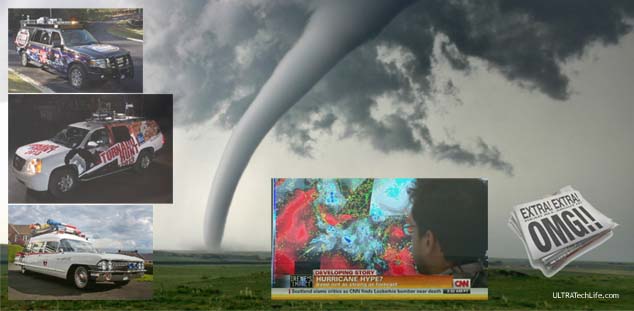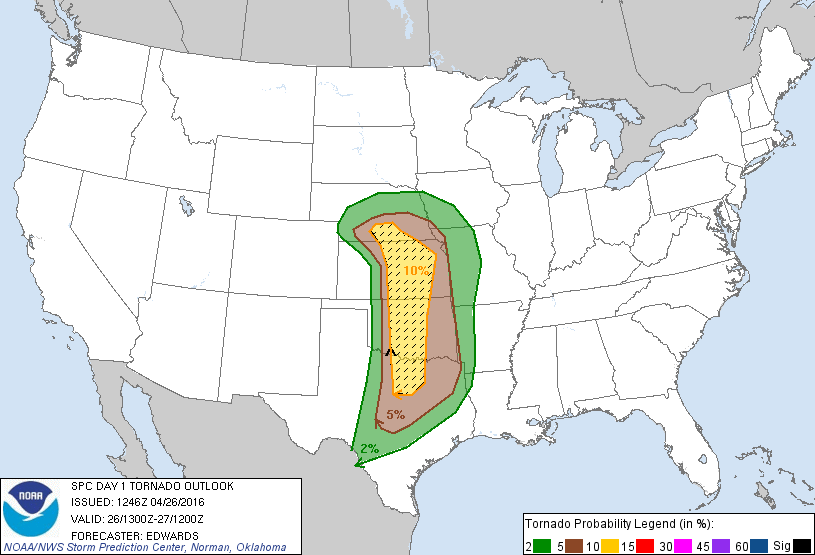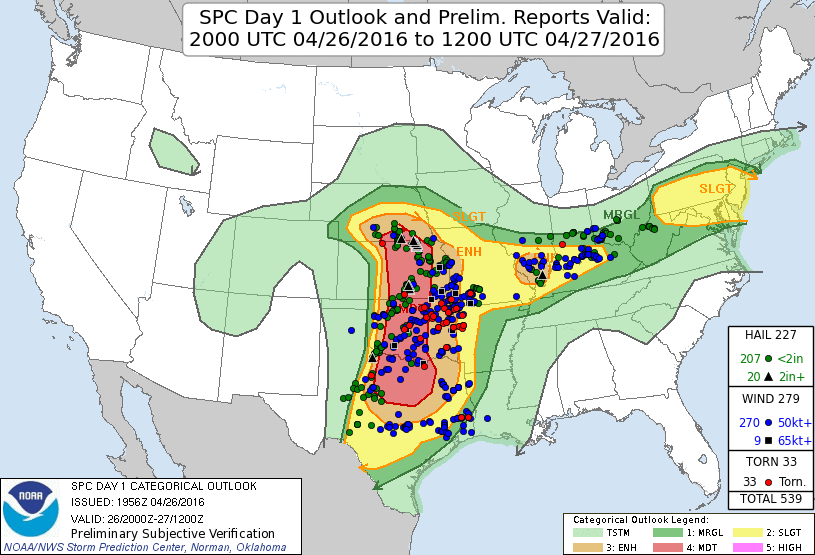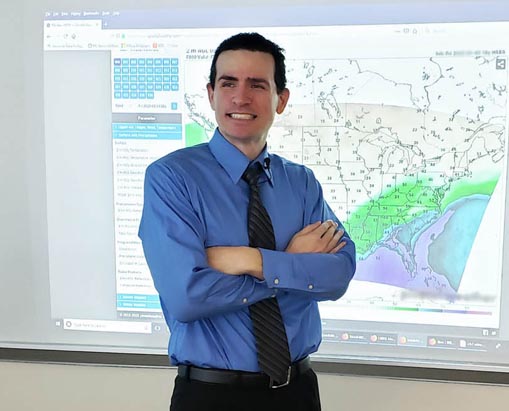Media Hype on Tornado Outbreaks Causes Public to Distrust Scientists

Recent overhyped severe weather coverage has caused concern about public trust in meteorologists. April 26, 2016 was another example of severe weather communication issues. There were very misleading graphics from some media meteorologists that suggested a 100% chance of killer tornadoes, which prompted many people to panic. To complicate matters, it wasn’t a great tornado watch forecast, which sometimes happens. The hype, of course, didn’t pan out to the unscientific expectations it presented. This highlights a problem with how severe weather information is communicated to the public. Tuesday’s situation was more of a problem with unscientific hype from multiple sources, which ultimately leads to the public distrusting meteorologists that are actually practicing sound science. Despite overhyped media coverage, the official government weather watches and warning remain very accurate, overall.
A meteorology student recently asked me about public distrust of meteorologists, especially after they say killer tornadoes will happen and they don’t. There was another case of this happening this past Tuesday. Some news headlines even said it was a forecast failure (bust).
Tuesday’s severe weather events were near the threshold of the Storm Prediction Center’s (SPC) Potentially Dangerous Situation (PDS) Watch criteria. The scientific expectations were more/less verified that day, according to the data (see below). Severe weather outbreaks aren’t just limited to killer tornadoes. The definition of “outbreak” isn’t really defined, especially with the media and general public.
A PDS tornado watch event requires specific atmospheric conditions, supported by forecast data and current observations. These watches are rare and forecasts can never be 100% accurate. This wasn’t an excellent tornado outbreak forecast on the part of the SPC. The 4/26/2016 forecast data really didn’t seem to support the issuance of a PDS tornado watch that day. However, overall, the scientific data suggests that SPC watches are very accurate, which means the public should continue to heed them with confidence1, 2, 3, 4, 5.
The problem stems from public distrust of meteorologists, especially after the media hypes major severe weather outbreaks that don’t happen. The other major problem is how forecast uncertainty and context is communicated to the public. People were mad because they called into work, schools closed, money was lost, etc.
Whenever someone in a position of leadership says there is a 10/10 chance/risk (100% likely probability) of killer tornadoes, especially in an area that has previously experienced deadly twisters, it can create a bold response, including fear and panic. If you were watching various media outlets this week, you might have seen many scary graphics, suggesting a killer tornado outbreak was certain. This is a huge issue because not everyone understands what hatching, probability, coverage, and severe weather indices mean.
Years of sensational media coverage of severe weather events has resulted in some public impacts. For example, the word “outbreak” is immediately viewed as a day when the public should expect thousands of deaths, killer tornadoes, wall-to-wall storm chaser coverage, storm chasing vehicles with all kinds of slick advertisement/paint jobs, chaos, etc. It even encourages people to get in their cars, risk their lives, and try to get as close as possible to a tornado.
It’s not all of the media hyping unscientific weather information and gimmicks, but it’s a lot of them, including major networks. The media must involved in passing on severe weather information, but not injecting the sensational elements, which complicate all matters — and ultimately are a disservice to the public.
We have a problem with media meteorologists (online, television, and radio) not practicing sound science. In meteorology, sound science means practicing forecasting techniques that have been scientifically proven, accurate, reproducible, verified by peer reviewed sources, and useful for operational purposes. Once hype is generated, it quickly spreads through the rest of the news media and social media outlets. A large portion of people get their weather information from television sources, according to available survey data 1, 2. Watches and warnings must be communicated in a uniform voice, which means everyone should be on the same page.
Much of the severe weather hype comes from marketing gimmicks designed to get ratings, of course.

Severe weather gimmicks are all over the place – and they get ratings. These gimmicks give meteorologists that are practicing sound science (actual science) a bad name. In addition, it also causes the public to distrust science, when tornado outbreaks don’t happen, especially after they are hyped by the media.
Weather forecast hype creates unreal expectations of forecasters. The end result is a portion of the general public distrusting meteorologists.
One great example of a misleading weather graphic is KFOR’s Chief Meteorologist Mike Morgan’s recent KFOR forecast graphic, which seemed to indicate a 100% risk/chance of tornadoes in his viewing area for April 26, 2016. The general public views this as a sure thing – and why blame the public for being upset when the 100% chance didn’t amount?
SVR/TOR Outlook next 10 days K4 Viewing area. 1PM Tuesday Update pic.twitter.com/0Dx5CcsgHY
— Mike Morgan (@MikeMorganKFOR) April 26, 2016
Over the past 10 years, a considerable number of television and radio stations have been using various gimmicks and hype tactics for weather coverage, such as “Killer Tornado Threat Index”, “XYZ’s Cycles”, naming storms, etc. Examples of sensational weather coverage/hype are all over the internet (also a humorous guide to sensational weather coverage, via Daily Kos)1, 2, 3, 4, 5, 6.
There are just too many examples of baseless hype to mention here. Some of these can even sound legitimate to other scientists. These are great ways to get ratings, but it’s dangerous to roll the dice when it comes to public safety. One thing an actual scientist finds (in nearly all of these cases) is that these gimmicks offer no scientific testability or explanation, no peer review, no meaningful purpose, poor accuracy, and ultimately, a great potential to cause the public to distrust the actual science community.
But they have degrees and all meteorologists are the same, right? There’s a general truth about educational backgrounds, even if someone is in a position of leadership. Simply having a degree in meteorology, or certification from a meteorology organization, doesn’t necessarily mean that person is a good forecaster, accurate, confident, or even practicing science, which is a really unfortunate reality. For example, you can have two people graduate from the same great school with the same degree, but only one of them goes on to stand out from the rest, practicing hard science, having a good work ethic, keeping up with the times, etc. It’s just the truth for any subject, profession, career, etc. You get out what you put in, typically.
“I finished school and went into TV weather. I had no idea that it basically meant I would leave the science behind and just become more of a reporter with a 5 minute segment where I stand in front of graphics and try to hold an audience that isn’t interested in science,” said Dave, a broadcast meteorologist that wishes to remain anonymous for fear of losing his job.
Broadcast meteorologists are often put in difficult positions that value their ability to hold an audience (ratings) more than their ability to present accurate scientific information to the public (science/facts).
CNN meteorologist Chad Myers once told Adweek: “I’ve worked at many local stations. I’ve worked in Columbus, Ohio; Detroit, Michigan; Oklahoma City, and news directors will always say, ‘Hey, bump up your numbers a little bit, make it sound a little more juicy.’ We don’t do that at CNN because we don’t have to, because would have to bump up everything.” Obviously, this is an example of baseless hype, not sound science.
It’s really bad that it only takes a few bad figures to skew the public’s view. Again, not all media meteorologists are bad, but the practice of baseless weather hype isn’t rare. Just one major overhyped weather event can cause a large amount of the public to label all meteorologists as spin doctors. In fact, there are many dedicated broadcast meteorologists who continue to provide excellent weather coverage for their audience.
Do we blame the online and TV meteorologists alone? No. However, they must be responsible for their own forecasts, gimmicks, graphics, etc. It’s worth mentioning that many media executives will encourage anything that gets ratings, regardless of what the scientific community thinks. Are you a meteorologist or just someone pointing to graphics talking about the weather? Ratings should never come before public safety.
Some people involved in hyping unscientific severe weather forecast information may think they are serving a good purpose (mean well), but it’s a mistake. A good meteorologist will learn from mistakes. Everyone makes mistakes, but to knowingly continue pushing misleading, sensational, hyped, unscientific severe weather forecast gimmicks on the public only results in increasing public distrust of science. In some cases, it could even result in “Cry Wolf Syndrome,” which means there will be a point of so much failure that the public no longer takes severe weather warnings seriously, which could mean more deaths.
The takeaway from this event is the fact the way severe weather forecasts are communicated to the public should be examined, especially with the media. The very nature of weather forecasting means models aren’t always a 100% accurate representation of the atmosphere — busts are going to happen. Forecasts busts are an opportunity for all meteorologists to learn from mistakes and improve future operations. Over the past two decades, our tornado outbreak watches/forecasts have been, in general, very accurate, often providing several days/hours of advanced notice. Severe weather forecasts are a matter of public safety and national security, there should be no unscientific gimmicks involved at any point in the process.
Here is what actual science said about the tornado outbreak probability on April 26, 2016.


Notice that the probability of a tornado was roughly 10%. The area of risk covered multiple states. What actually happened was very close to the SPC criteria (above), which means scientists didn’t fail that day. It’s also worth noting that (to a scientist) 10% has significance in the meteorological context of tornado probability.
A major tornado outbreak didn’t happen this past Tuesday. However, we will eventually get another major tornado outbreak. It’s critical to communicate sound science to the public, especially when lives and property are involved.
One great suggestion for the public would be to get their information directly from the National Weather Service (NWS) and SPC. They both have websites that offer free, up-to-date, accurate, location specific, severe weather information.
Having a NOAA Weather Radio Alert will also ensure you get the latest severe weather and tornado warnings – without any hype, misleading graphics, or advertisements – just the facts.
There is always room for improvement, even with the NWS and SPC. Accurate PDS tornado watches and outbreak forecasts are one of the highest priorities of our country.
It might be time for the SPC to create a small PDF primer for all media outlets (and so the general public can read it), regarding how to communicate severe weather outbreaks, audience needs, tornado probability, etc. The link should be placed on the top of the SPC’s page during weather outbreaks so the public can get easy access. The same language could also be discussed on NOAA weather radios, whenever a PDS watch is issued, kind of a more exact explanation of why it was issued and what it means for various audiences (public, hospitals, schools, business, etc.).
How Early Should Public Watches & Warnings Be Issued?
There are two different audiences to consider when forecasting severe weather outbreaks. For example, hospitals need more than minutes or seconds to prepare for severe weather outbreaks, which means giving them more than a days’ notice would be great. However, a family doesn’t need 24 hours to prepare for a tornado.

It might be time to provide two different severe weather forecast messages: one for the public and one for business/aviation/hospitals. This doesn’t mean issuing two watches or warnings for each severe weather event. For example, a solution could be to add a one paragraph into convective outlooks that details what the forecast means for various audiences.
Finally, the public should rest assured that the scientists at the NWS and SPC have had great success with forecast verification, which means that they are very accurate and reliable. Always take severe weather watches and warnings seriously. Despite some media headlines about Tuesday’s tornado forecast “bust”, the accuracy of today’s modern weather forecasting remains excellent.
It’s generally a good idea to be prepared, rather than upset, even when a severe weather outbreak isn’t as large as expected – or doesn’t happen. Think of this as a chance for the government, media, public, schools, and business to practice severe weather preparedness — because a major outbreak will happen (in the future). Improvements can be made, but everyone has to do their part.
More about author.
